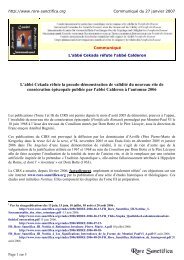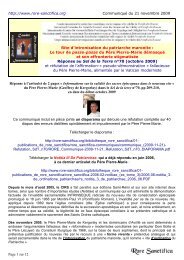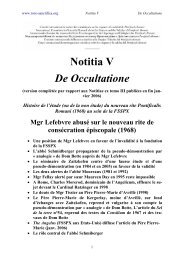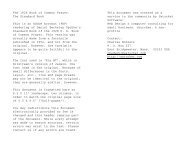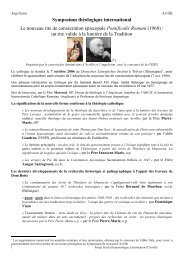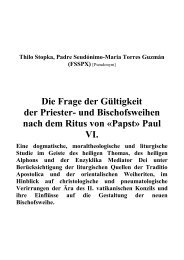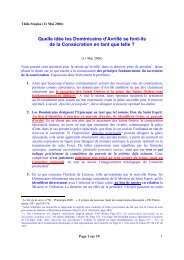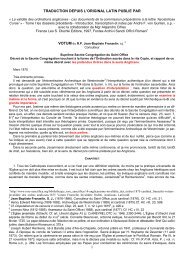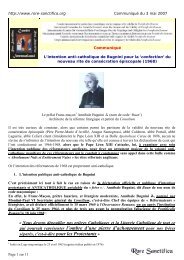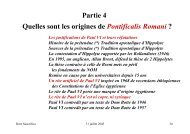THE ORDER OF MELCHISEDECH A Defence of ... - Rore Sanctifica
THE ORDER OF MELCHISEDECH A Defence of ... - Rore Sanctifica
THE ORDER OF MELCHISEDECH A Defence of ... - Rore Sanctifica
Create successful ePaper yourself
Turn your PDF publications into a flip-book with our unique Google optimized e-Paper software.
priest not simply in degree but in essence from a layman, as Vatican II teaches with admirable<br />
clarity in no. 10 <strong>of</strong> Lumen gentium. As is explained on page 81, the form in the traditional rite,<br />
carried over virtually unchanged into the 1968 Ordinal, is indeterminate. There is not a word in it<br />
that is incompatible with Protestant belief. But this indeterminate form was given an<br />
unambiguously Catholic connotation by other prayers and ceremonies in the traditional rite, prayers<br />
and ceremonies which were all removed or considerably modified in the 1968 Ordinal.<br />
My condemnation <strong>of</strong> the ambiguity <strong>of</strong> the 1968 Ordinal was vindicated by three remarkable<br />
testimonies. The first was a letter from an English bishop praising my book and assuring me that<br />
my reservations concerning the new Ordinal were shared by the hierarchy <strong>of</strong> England and Wales<br />
which had protested to Rome at its imposition in 1968 (the faith still meant something to these<br />
bishops, most <strong>of</strong> whom had been appointed before the Council). The second vindication can be<br />
found in a long review <strong>of</strong> my book by Dr. Francis Clark, who is certainly one <strong>of</strong> the greatest <strong>of</strong> all<br />
living authorities on the Sacrament <strong>of</strong> Order. While Dr. Clark accepted that my criticism was<br />
justified, he insisted that the Catholicity <strong>of</strong> the 1968 Ordinal was guaranteed by a number <strong>of</strong> ex<br />
adiunctis factors, an argument which I accept. Some <strong>of</strong> his comments will be cited at length later in<br />
this introduction. The third, most authoritative, and most dramatic confirmation <strong>of</strong> my thesis is that<br />
<strong>of</strong> a spokesman for the Congregation for Divine Worship and the Discipline <strong>of</strong> the Sacraments<br />
(CDWS) in the February 1990 issue <strong>of</strong> Notitiae. In 1989, following continued criticisms <strong>of</strong> the<br />
ambiguity <strong>of</strong> the 1968 Ordinal, a second typical edition was published with a number <strong>of</strong> revisions.<br />
It may even be possible that my book, which was presented to twelve <strong>of</strong> the more traditional<br />
cardinals in the Curia, played some small part in this decision. The CDWS accepted the fact that<br />
whereas the Catholic theology <strong>of</strong> the priesthood was made explicit in the Traditional Ordinal this<br />
was no longer the case in that <strong>of</strong> 1968. It admitted that the New Ordinal had "aroused frequent<br />
criticism from both bishops and priests as well as the ordinands themselves", and went on to claim<br />
that its 1989 revision had rectified its deficiencies. It is my contention that the 1989 Ordinal is only<br />
marginally better than that <strong>of</strong> 1968, and that it is still far from adequate as a liturgical expression <strong>of</strong><br />
the Catholic doctrine <strong>of</strong> the priesthood. The 1989 Ordinal is examined in great detail in Appendix<br />
IX. The frank admission by the CDWS <strong>of</strong> the deficiencies <strong>of</strong> the 1968 Ordinal vindicates fully my<br />
criticisms <strong>of</strong> it in this book.<br />
Criticisms <strong>of</strong> the First Edition<br />
In a long review which appeared in the June 1979 issue <strong>of</strong> Christian Order, Dr. Francis Clark<br />
expressed the opinion that the analogy that I had drawn between Cranmer's Ordinal and the 1968<br />
Catholic Ordinal could not bear the weight that I had put upon it, and broke down at a certain point:<br />
The new English rites composed in the reign <strong>of</strong> Edward VI had an objective anti-sacerdotal stamp<br />
because history demonstrates that the supreme authority which ordered and sanctioned the liturgical<br />
changes, imposing them by the combined power <strong>of</strong> State and Church, was determined to eliminate<br />
the Catholic Mass and priesthood. The authors <strong>of</strong> the Anglican Ordinal were themselves part <strong>of</strong> the<br />
politico-religious regime that vested it with authority, and the total anti-sacerdotal significance <strong>of</strong><br />
the rite stems above all from that <strong>of</strong>ficial stamp. But when we look at the other term <strong>of</strong> Mr. Davies's<br />
analogy we find the case is altered. Even if some <strong>of</strong> the promoters <strong>of</strong> the new Roman rites in the<br />
decade following Vatican II were animated by a questionable theological liberalism, even if<br />
Protestant "observers" were accorded a role which enabled them to influence (informally but<br />
effectively) the deliberation <strong>of</strong> the Roman Consilium which drafted the new rites, there is not the<br />
slightest doubt that the supreme authority that sanctioned the changes, the Holy See, was<br />
determined to maintain intact the full Catholic doctrine <strong>of</strong> the Mass and the priesthood. The new<br />
forms, liturgically impoverished though they are, are nevertheless still vested with the sacred<br />
significance which the supreme authority <strong>of</strong> the Catholic Church attaches to its sacraments,<br />
ministry, and rites. The documents <strong>of</strong> the Second Vatican Council and the teaching <strong>of</strong> Pope Paul VI<br />
are the contemporary overall context which objectively supplies the due meaning which is no<br />
longer explicit in the ritual forms. This is the overriding determinatio ex adiunctis which safeguards



